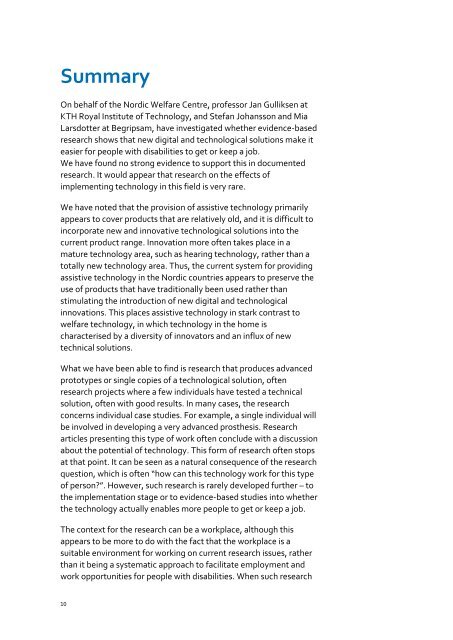You also want an ePaper? Increase the reach of your titles
YUMPU automatically turns print PDFs into web optimized ePapers that Google loves.
Summary<br />
On behalf of the Nordic Welfare Centre, professor Jan Gulliksen at<br />
KTH Royal Institute of Technology, and Stefan Johansson and Mia<br />
Larsdotter at Begripsam, have investigated whether evidence-based<br />
research shows that new digital and technological solutions make it<br />
easier <strong>for</strong> people with disabilities to get or keep a job.<br />
We have found no strong evidence to support this in documented<br />
research. It would appear that research on the effects of<br />
implementing technology in this field is very rare.<br />
We have noted that the provision of assistive technology primarily<br />
appears to cover products that are relatively old, and it is difficult to<br />
incorporate new and innovative technological solutions into the<br />
current product range. Innovation more often takes place in a<br />
mature technology area, such as hearing technology, rather than a<br />
totally new technology area. Thus, the current system <strong>for</strong> providing<br />
assistive technology in the Nordic countries appears to preserve the<br />
use of products that have traditionally been used rather than<br />
stimulating the introduction of new digital and technological<br />
innovations. This places assistive technology in stark contrast to<br />
welfare technology, in which technology in the home is<br />
characterised by a diversity of innovators and an influx of new<br />
technical solutions.<br />
What we have been able to find is research that produces advanced<br />
prototypes or single copies of a technological solution, often<br />
research projects where a few individuals have tested a technical<br />
solution, often with good results. In ma<strong>ny</strong> cases, the research<br />
concerns individual case studies. For example, a single individual will<br />
be involved in developing a very advanced prosthesis. Research<br />
articles presenting this type of work often conclude with a discussion<br />
about the potential of technology. This <strong>for</strong>m of research often stops<br />
at that point. It can be seen as a natural consequence of the research<br />
question, which is often “how can this technology work <strong>for</strong> this type<br />
of person?”. However, such research is rarely developed further – to<br />
the implementation stage or to evidence-based studies into whether<br />
the technology actually enables more people to get or keep a job.<br />
The context <strong>for</strong> the research can be a workplace, although this<br />
appears to be more to do with the fact that the workplace is a<br />
suitable environment <strong>for</strong> working on current research issues, rather<br />
than it being a systematic approach to facilitate employment and<br />
work opportunities <strong>for</strong> people with disabilities. When such research<br />
10

















